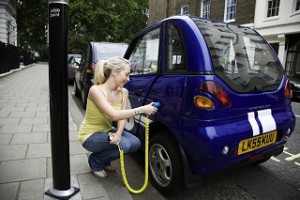How Important is “Vehicle-to-Grid” in the EV Adoption Curve?
There is no doubt that electric transportation will make terrific headway over the coming couple of decades. Here, Forbes suggests that one-quarter of the cars on the road in 2040 will be EVs. Fair enough. But the author goes on to suggest that the opportunities that this will create for V2G (vehicle to grid, enabling the grid to absorb peak power from idle EVs) represents the “tipping point for renewable energy.”
I can’t say that this is impossible, but it’s extremely unlikely. First of all, look at the consumer mentality associated with this. Imagine that an EV driver shown here parks her car to go to work, or buy groceries, or go inside her home knowing that she’s going to have to get to work (on time!) again in the morning. Now imagine that she has in the back of her mind: My car may be out of charge when I get back in it. How well can we expect that nagging worry to sit with her?
Now, let’s look at the whole ensemble of renewable energy coming on line, and what that’s going to look like 23 years from now. How important is the storage associated with EVs going to be in all that? Well, it’s impossible to say for sure, but think of all the changes that will almost certainly occur between now and then: affordable batteries at utility-scale and in a distributed setting, low-cost high-voltage transmission (sending power to wherever it may be needed in realtime), the integration of different types of renewables with different availability profiles, demand response, and so many others.
Sorry, this one, albeit interesting, is off-base.


Craig,
Where do you find your photos? :)Range anxiety isn’t the only worry to beset the young lady in photo if she bought a truly horrible little EV like that in the picture.
Essentially I agree with your analysis. The idea of integrating EV’s as part of a grid storage facility is absurd.
Like battery swapping, it sounds good until you look at the problem closely, and realize not only is the technology incompatible, but the whole concept impractically naive.
Lol. Good point about the photo. Laziness on my part.